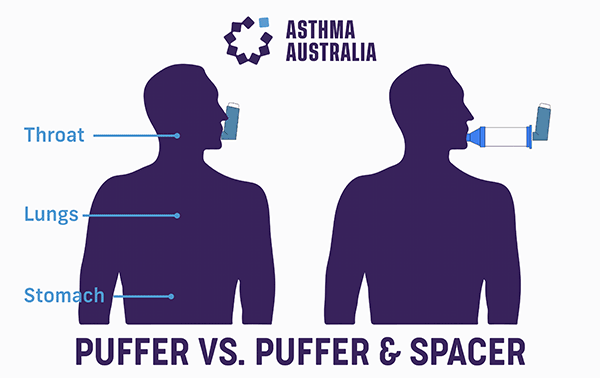To ensure your child with asthma receives the correct dose of their asthma preventer and reliever medications, it’s not just taking it at the right time, it is also taking it in the right way.
Spacers can be a highly effective way for children with asthma to take their reliever medication so the correct dose goes into the lungs where it is needed.
Asthma Australia Senior Asthma Educator Gemma Crawley says everyone should use a spacer but it is even more important for children.
She says spacers slow down the delivery of the puffer medication and allow the child to breathe it at their own pace.

“The spacer allows time for a child to inhale,” she says.
“When you puff medication into the mouth without a spacer it can go to the back of the throat so quickly, they haven’t got time to inhale correctly.”
“They will end up swallowing the majority of that medication.”
A spacer is a container, in a range of shapes and sizes, with a mouthpiece at one end and a hole at the other end to fit the puffer.
The effective use of a spacer provides the best chance for a child with asthma to get the right dose of their medication while helping to minimise potential side effects.
The spacer should be clean, washed in soapy water, and left to air dry.
For children, Ms. Crawley says, it can be best to perform the “four-breath” technique.
This is where they shake the puffer and insert it into the end of the spacer.
Then they put the mouthpiece in their mouth and form a good seal with their lips.
The next step is to breathe out and puff one dose into the spacer, before breathing gently in and out four times.
She says it is critical to have twice-yearly checks to make sure their technique is correct.
“It’s extremely important to have a face to face check with a health professional, whether that is a doctor, a nurse or a pharmacist to check the child’s technique,” she says.
“The majority of people do not take their medications correctly.
“They’re not getting the dose they think they’re getting and especially with their preventers, that has implications for their asthma control.”
She says the inhaler technique will be among the first things a health professional will check if a person with asthma’s control has worsened.
As children return to school, Asthma Australia wants parents and kids to be “asthma-ready”.
February is often a time of increased risks of asthma flare-ups when kids can experience more symptoms. There are increased presentations and admissions for asthma to hospital.
Asthma Australia is making it easier to be prepared with their Back to School Asthma Checklist.
It encourages a check in with your child’s doctor for an asthma review and up-to-date Asthma Action Plan, to visit your local pharmacy to purchase spare asthma medication and check spacer technique and to talk with school staff about your child’s asthma management.
Asthma is a lifelong condition and right now, there isn’t a cure. But, for most of the one in nine Australians who have asthma, it can be managed well.
To prepare for Back To School, download the Asthma Checklist.
Partners
echamber and Flo are campaign partners of Asthma Australia and have not been involved in the development of this web page/content.





 1800 278 462
1800 278 462





